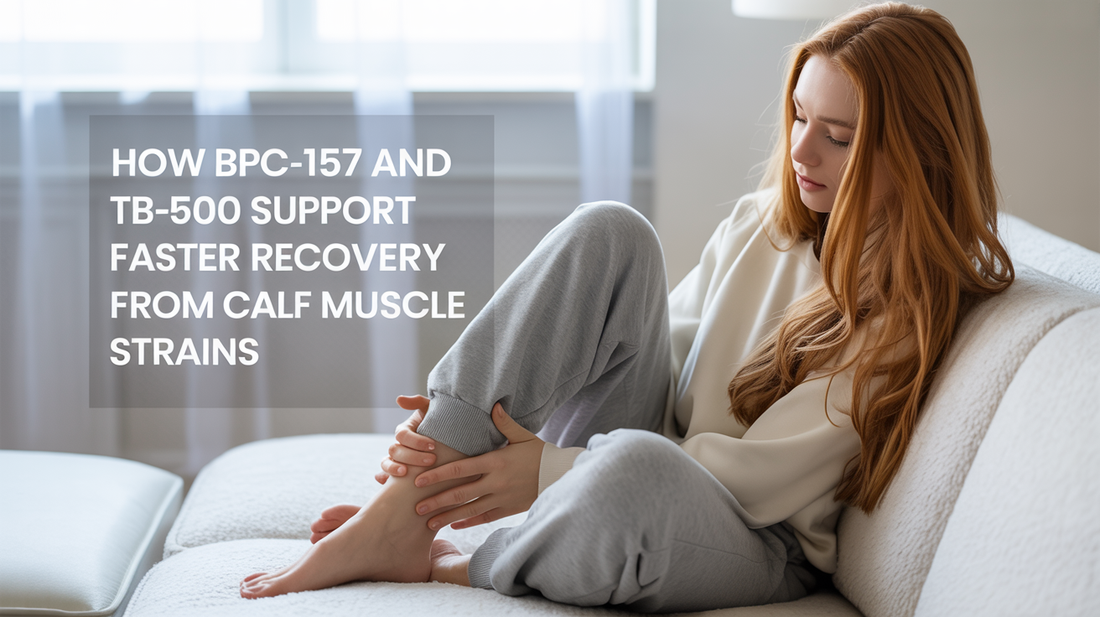
How BPC-157 and TB-500 Support Faster Recovery from Calf Muscle Strains
Share
Regenerative peptides like BPC-157 and TB-500 have gained attention for their potential to accelerate healing from muscle injuries, including calf muscle strains. By targeting tissue repair and reducing inflammation, these compounds can help athletes and active individuals return to training faster and with less risk of re-injury.
The Challenges of Calf Muscle Strains
Calf strains occur when the gastrocnemius or soleus muscle fibers are overstretched or torn, often during explosive movements like sprinting, jumping, or sudden changes in direction. These injuries can cause a wide range of problems:
- Sharp pain and swelling in the lower leg, sometimes accompanied by tenderness that radiates upward.
- Difficulty walking, climbing stairs, or pushing off the foot, which can disrupt daily life.
- Limited ankle flexibility and reduced mobility, making athletic activity feel restricted.
- Bruising or discoloration in more severe cases where fibers are torn.
- Muscle weakness and instability that heighten the chance of reinjury.
- High recurrence risk if recovery is rushed, with repeated strains often lasting longer.
Because calf muscles are heavily engaged in every step, they are under near-constant stress. Recovery can therefore be slow, and setbacks are common without structured treatment. Untreated strains can even create compensatory issues in the Achilles tendon, knees, and hips.
How BPC-157 and TB-500 Aid Recovery
Peptides such as BPC-157 and TB-500 support muscle and connective tissue healing through multiple mechanisms that go beyond standard rest and physiotherapy:
- Stimulate blood vessel growth – improving circulation to injured tissues for faster nutrient and oxygen delivery, and helping clear metabolic waste.
- Promote collagen synthesis – strengthening muscle fibers, tendons, and ligaments involved in calf function and resilience.
- Reduce inflammation – minimizing pain, swelling, and scar tissue buildup that can slow recovery and reduce mobility.
- Enhance cell migration and repair – enabling damaged muscle fibers to regenerate more efficiently and completely.
- Increase flexibility and resilience – helping tissues withstand stress and lowering the risk of repeat strains.
- Support neuromuscular coordination – encouraging smoother recovery by reinforcing nerve-muscle communication.
By working together, these peptides create an environment conducive to faster and more complete healing. Athletes and active adults may notice not only quicker recovery but also stronger tissue integrity for the long term.
Benefits for Athletes and Active Individuals
The use of regenerative peptides for calf strain recovery can provide:
- Quicker return to activity without compromising tissue integrity and allowing athletes to safely resume training sooner than with rest alone.
- Lower recurrence rates thanks to stronger, more resilient muscle fibers and connective tissue that adapt better to repeated stress.
- Improved mobility and flexibility for running, jumping, cycling, and everyday movement, restoring stride mechanics and range of motion.
- Greater confidence in recovery, reducing the fear of setbacks during rehabilitation and enabling mental focus on training rather than worry about reinjury.
- Better endurance and stability because of improved circulation and structural support that sustain higher workloads over time.
- Enhanced athletic performance post-recovery as stronger tissues provide a more solid base for speed, agility, and power.
- Smoother integration with physiotherapy since peptides complement stretching, strengthening, and mobility drills for a more holistic recovery process.
- Support for older or recreational athletes who may heal slower, giving them a tool to stay active with fewer interruptions.
For athletes, these benefits mean less downtime, more consistent training cycles, and long-term durability of muscle health. For active adults, they allow greater freedom of movement, reduced discomfort in daily life, and the ability to continue recreational pursuits without fear of recurring strains.
Safety and Considerations
- Medical supervision is essential – peptide use should be guided by a healthcare professional.
- Quality sourcing – only trusted suppliers should be used to ensure purity and effectiveness.
- Individual variability – response to peptides may differ depending on injury severity, age, and overall health.
- Rehabilitation synergy – peptides are most effective when combined with stretching, strength training, and nutrition.
The Future of Muscle Recovery
As interest in regenerative therapies grows, BPC-157 and TB-500 are emerging as promising options for managing common sports injuries like calf strains. By promoting faster healing, enhancing tissue strength, and reducing re-injury risk, they may help athletes maintain peak performance while protecting long-term muscle health.
